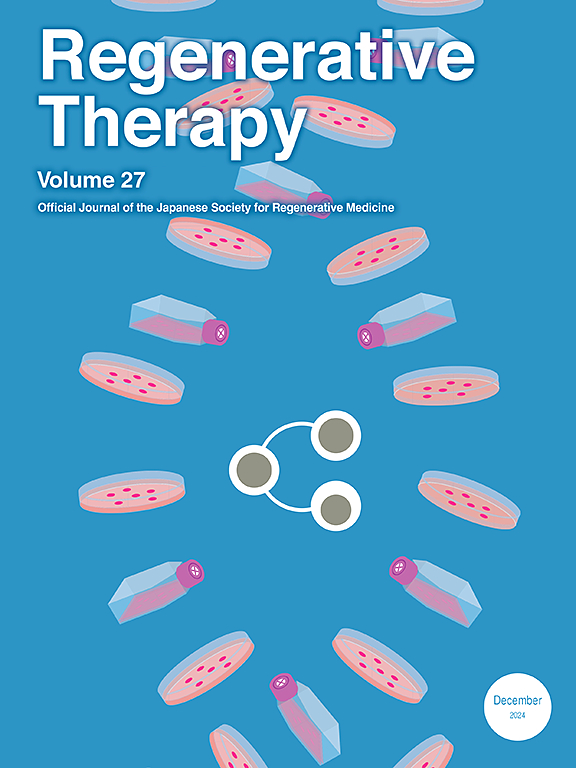Extracellular vesicles-delivered circDB promotes ischemic muscle repair through the miR-34a/USP7/Notch1 signaling pathway
IF 3.5
3区 环境科学与生态学
Q3 CELL & TISSUE ENGINEERING
引用次数: 0
Abstract
Introduction
The incidence of lower limb ischemic diseases has been rising steadily in recent years, often leading to severe outcomes such as limb amputation. Given the limited availability of effective treatments, there is a critical need for novel therapeutic strategies. This study explores the reparative role and underlying mechanisms of extracellular vesicles derived from human umbilical cord mesenchymal stem cells (UMSC-EVs) in promoting ischemic hindlimb recovery through the delivery of circular RNA circDB.
Methods
A hindlimb ischemia model was established in C57BL/6 mice via femoral artery ligation, followed by intramuscular injections of extracellular vesicles derived from either untreated UMSCs (NC-EVs) or UMSCs transfected with si-circDB (si-EVs). Functional recovery was assessed using Laser Doppler imaging for blood flow, grip strength tests, and treadmill endurance evaluations. Molecular analyses included Western blot and qRT-PCR for USP7 and Notch1 expression, EdU assays for myoblast proliferation, and co-immunoprecipitation to confirm USP7-Notch1 interactions. In vitro, C2C12 myoblasts were cultured under hypoxic conditions for 48 h to mimic ischemia, and their proliferation and signaling were studied using similar techniques. Bioinformatics tools (CircBank, TargetScan) were used to analyze circDB-miR-34a interactions.
Results
We found that circDB expression is markedly reduced in ischemic hindlimb tissues and is closely associated with tissue repair. In a murine hindlimb ischemia model, localized injection of UMSC-EVs into ischemic muscle significantly enhanced blood flow recovery, improved muscle function, and increased expression of USP7 and Notch1. Additionally, a hypoxia-induced myoblast injury model in vitro revealed that UMSC-EVs delivering circDB promoted myoblast proliferation via the miR-34a/USP7/Notch1 signaling axis.
Conclusion
Extracellular vesicles circDB enhances ischemic muscle repair by modulating the miR-34a/USP7/Notch1 pathway. These findings highlight a novel mechanism by which UMSC-derived extracellular vesicles facilitate muscle regeneration and suggest a promising therapeutic approach for lower limb ischemic diseases.
细胞外小泡递送的circDB通过miR-34a/USP7/Notch1信号通路促进缺血肌肉修复
近年来,下肢缺血性疾病的发病率稳步上升,往往导致截肢等严重后果。鉴于有效治疗的可用性有限,迫切需要新的治疗策略。本研究探讨了来自人脐带间充质干细胞(umsc - ev)的细胞外囊泡通过递送环状RNA circDB促进缺血性后肢恢复的修复作用和潜在机制。方法通过股动脉结扎建立C57BL/6小鼠后肢缺血模型,然后肌内注射未经处理的UMSCs (nc - ev)或转染si-circDB的UMSCs (si- ev)的细胞外囊泡。使用激光多普勒成像血流、握力测试和跑步机耐力评估来评估功能恢复。分子分析包括Western blot和qRT-PCR检测USP7和Notch1的表达,EdU检测成肌细胞增殖,以及共免疫沉淀来确认USP7-Notch1的相互作用。体外模拟缺血,在缺氧条件下培养C2C12成肌细胞48 h,采用类似技术研究C2C12成肌细胞的增殖和信号传导。使用生物信息学工具(CircBank, TargetScan)分析circDB-miR-34a的相互作用。结果我们发现circDB在缺血后肢组织中表达明显降低,与组织修复密切相关。在小鼠后肢缺血模型中,局部向缺血肌肉注射umsc - ev可显著促进血流恢复,改善肌肉功能,并增加USP7和Notch1的表达。此外,体外缺氧诱导的成肌细胞损伤模型显示,传递circDB的umsc - ev通过miR-34a/USP7/Notch1信号轴促进成肌细胞增殖。结论细胞外囊泡circDB通过调控miR-34a/USP7/Notch1通路增强缺血肌肉修复。这些发现强调了umsc来源的细胞外囊泡促进肌肉再生的新机制,并为下肢缺血性疾病的治疗提供了一个有希望的方法。
本文章由计算机程序翻译,如有差异,请以英文原文为准。
求助全文
约1分钟内获得全文
求助全文
来源期刊

Regenerative Therapy
Engineering-Biomedical Engineering
CiteScore
6.00
自引率
2.30%
发文量
106
审稿时长
49 days
期刊介绍:
Regenerative Therapy is the official peer-reviewed online journal of the Japanese Society for Regenerative Medicine.
Regenerative Therapy is a multidisciplinary journal that publishes original articles and reviews of basic research, clinical translation, industrial development, and regulatory issues focusing on stem cell biology, tissue engineering, and regenerative medicine.
 求助内容:
求助内容: 应助结果提醒方式:
应助结果提醒方式:


